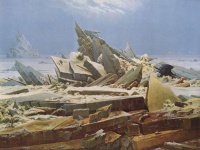German art
From The Art and Popular Culture Encyclopedia

|
Related e |
|
Featured: |
German art describes the history of the visual arts in Germany
Hans Holbein the Elder and his brother Sigismund Holbein painted religious works in the late Gothic style. Hans the Elder was a pioneer and leader in the transformation of German art from the Gothic to the Renaissance style. Hans Holbein the Younger painted in the Northern Renaissance style.
The German Renaissance was a result of German artists who had travelled to Italy to learn more and become inspired by the Renaissance movement. Albrecht Dürer was a well known German artist of this period. During the first few years from 1495 onwards he worked in the established Germanic and northern forms but was open to the influences of the Renaissance. After visiting Italy, Dürer was back in Nuremberg by mid-1507, remaining in Germany until 1520.
Contents |
19th century
20th century
Plakatstil, was an early poster style of art that began in the early 1900s and originated out of Germany. "Plakatstil" means "poster style" in German. The traits of this style of art are usually bold, straight font with very simple design.
- Der Blaue Reiter established in Munich, Germany in 1911. Wassily Kandinsky, Franz Marc, August Macke, Alexej von Jawlensky, Marianne von Werefkin and others founded the group in response to the rejection of Kandinsky's painting Last Judgement from an exhibition by Neue Künstlervereinigung.
- Die Brücke was a group of German expressionist artists formed in Dresden in 1905.
- Jugendstil
- The New Objectivity, or neue Sachlichkeit (new matter-of-factness), was an art movement which arose in Germany during the 1920s
Art in the third reich
Degenerate art (from the German: entartete Kunst) was the official platform adopted by the Nazi regime for banning modern art in favor of Heroic Art. According to Nazi thinking, Heroic Art symbolized racially pure art, free from distortion and corruption, while modern styles deviated from the prescribed norm of classical beauty. While the 1920s to 1940s are considered the heyday of modern art movements, there were conflicting nationalistic movements that resented abstract art, and Germany was no exception. Avant-garde German artists, mostly Expressionists, were now branded both enemies of the state and a threat to the German nation. Many went into exile and lost both their reputations and credibility.
The entartete Kunst exhibit premiered in Munich in March, 1937, and travelled to eleven other cities in Germany and Austria. The show was intended as an official condemnation of modern art, and included over 650 paintings, sculptures, prints, and books from the collections of thirty two German museums. Expressionism, which had its origins in Germany, contained the largest proportion of paintings represented. It was considered the first blockbuster art exhibit of the twentieth century, with an estimated attendance of three million visitors. The exhibition was far more popular than the nearby exhibition of officially sponsored so called heroic art.
Modern art
contemporary artists
Martin Kippenberger, Gerhard Richter, Sigmar Polke, Jonathan Meese, Daniel Richter, Albert Oehlen, Markus Oehlen, Georg Baselitz, Jörg Immendorf, Rosemarie Trockel, Thomas Ruff, Bernd und Hilla Becher, Anselm Kiefer, Neo Rauch, Martin Eder, Günther Uecker, Markus Lüpertz


